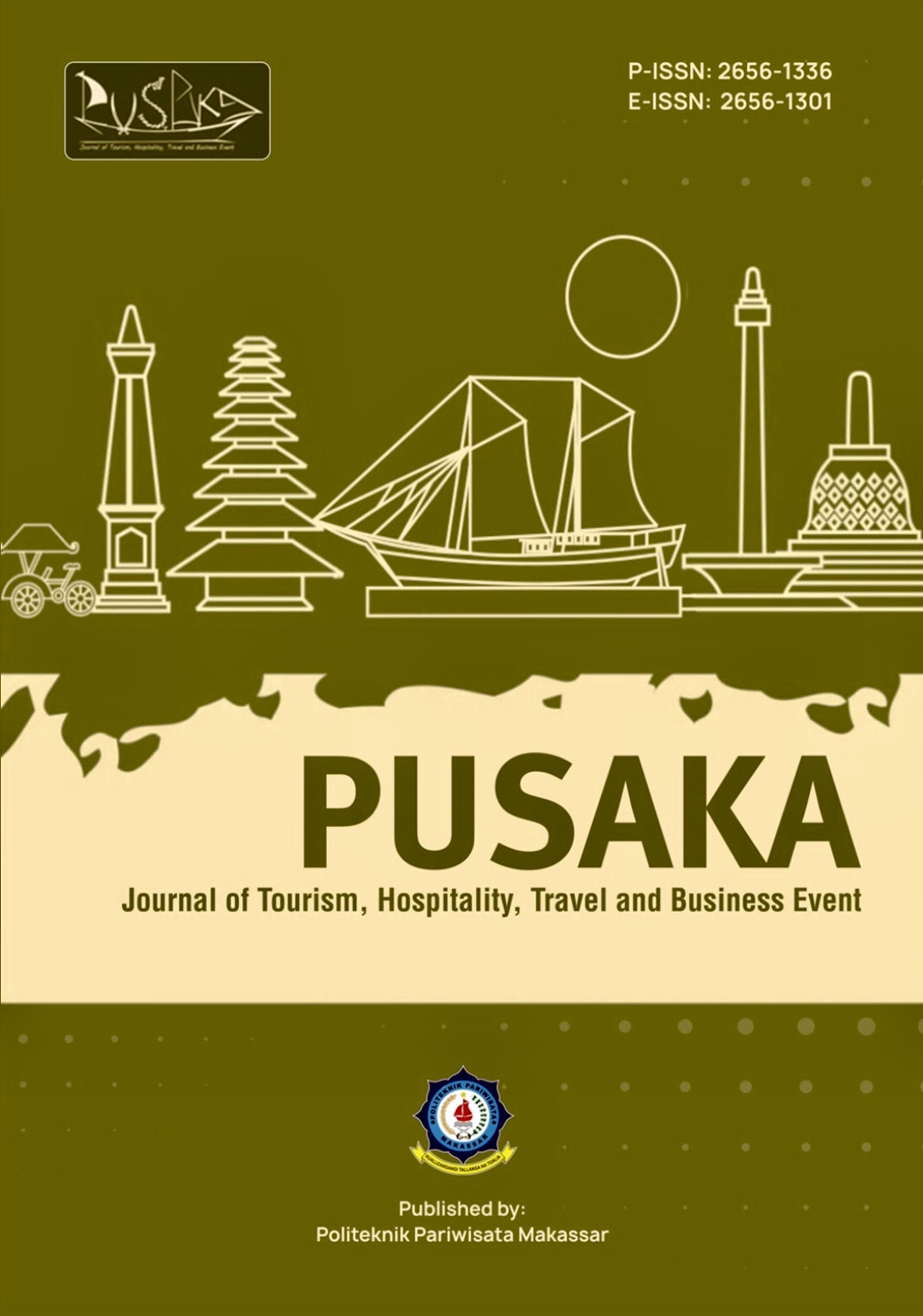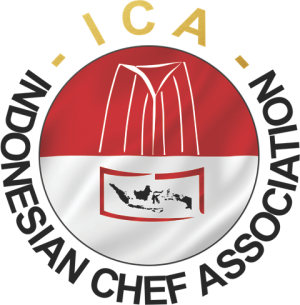Tourism Potential Resources Measurement: The Talaga Pancar Lake Case
DOI:
https://doi.org/10.33649/pusaka.v4i1.112Keywords:
Assessment Criteria, Potential Tourism ComponentAbstract
This paper is aimed to measure the potential resources of tourism based on the criteria of tourist attraction, accessibility, infrastructure and facilities, and environmental degradation. The research using a case study in Talaga Pancar Lake based on qualitative and quantitative data with a descriptive explanation. Data through depth interviews were obtained from the manager and operator, while observed and measuring the potential tourism resource by using a rating scale. Results showed that tourist attractions were a medium category, that's the existing natural tourist attractions were sufficient to be used as potential as natural tourist attractions. The available accessibility was a potential medium, that the place has sufficient infrastructure and superstructure for tourists to reach the place. The level of environmental degradation was medium, that the impact of damage to environmental assets conditions was insufficiently maintained. Infrastructure assets were a high category, which means that the availability of assets is much complete. While the availability of supporting facilities was not sufficient by the adequacy standard for tourism destination services.
References
Alaeddinoglu, Faruk., Can, Ali Selcuk. (2011). Identification and Classification of nature-based tourism resources: Western Lake Van basin, Turkey, Procedia-Social and Behavioral Sciences, 19, 198-207.
Andrianto, Tomy and A Gima Sugiama. (2016). The Analysis of Potential 4A’s Tourism Component in the Selasari Rural Tourism, Pangandaran, West Java. Asia Tourism Forum 2016 – The 12th Biennial Conference of Hospitality and Tourism Industry in Asia (ATF-16), Atlantis Press Publisher, pp. 136-144.
Ariya, G., Wishitemi, B., & Sitati, N. (2017). Tourism destination attractiveness as perceived by tourists visiting Lake Nakuru National Park, Kenya. International Journal of Research in Tourism and Hospitality, Volume 2, Issue 4, 2017, PP 1-13.
Arrobas, Fernando., Jessica Ferreira., Eduardo BritoHenriques., and Antonio Fernandes, (2020). Measuring tourism and environmental sciences students’ attitudes towards sustainable tourism. Journal of Hospitality, Leisure, Sport & Tourism Education, Vol. 27, Nov. 2020, 100273, DOI: 10.1016/j.jhlste.2020.100273
Baum, Tom; Catherine Cheung., and Haiyan Kong. (2016). Sustainability and the Tourism and Hospitality Workforce: A Thematic Analysis. Sustainability.
Belsoy, Josphat; Jacqueline Korir; and Jacob Yego. (2012). Environmental Impacts of Tourism in Protected Areas. Journal of Environment and Earth Science, Vol 2, No.10, pp. 64-73
Bie, Wanwe, and Honggang Xu. (2018). How tourists perceived environmental value on Wetland Park Tourism influences their pro-environmental behavior. Asian Journal of Tourism Research, Vol. 3, No. 1, June 2018, pp. 88-115., Doi.org 10.12982 AJTR.2018.0004
Brunt, Paul; Susan Horner, and Natalie Semley. (2017). Research Methods in Tourism, Hospitality & Events Management. SAGE Publications Inc., California
Chin, Chee-Hua., Law, Fung-Yee., Lo, May-Chiun., Ramayah, T. (2018). The Impact of Accessibility Quality and Accommodation Quality on Tourist's Satisfaction and Revisit Intention to Rural Tourism Destination in Sarawak: The Moderating Role of Local Communities' Attitude. Global Business and Management Research: An International Journal, Vol.10, No.2 (2018, Special Issue)
Clius, Mioura., Patroescu, Maria. (2014). An Evaluation Matrix For Ecotourism Potential in Certain Categories of Protected Areas in Romania, Case Studies: National Parc, Nature Parc, Geopark. International Multidisciplinary Scientific GeoConferences, SGEM 2014 14.
Coccossis, H. (1997). Tourism and sustainability: Perspectives and Implications: Smjernice za procjenu prihvatnog kapaciteta sredozemnih obalnih podrucja za turizam, Institut za turizam, Zagreb.
Deng, J., King, B., & Bauer, T. (2002). Evaluating natural attractions for tourism. Annals of Tourism Research, 29(2), 422–438.
Djohan, Muhammad Iqbal., Rhiza Eka Purwanto, dan Yayan Dian Fitriansyah, (2020), Analisis Pengelolaan Water Sports Event Sebagai Destinasi Wisata Olahraga di Danau Ranau Kab. Oku Selatan Prov. Sumatera Selatan, Journal of Tourism, Hospitality, Travel and Busines Event Volume 2, No.2., pp. 84-97
Dokulil, Martin T. (2014). Environmental Impacts of Tourism on Lakes, Ch 7, Eutrophication: Causes, Consequences and Control, Springer Science, DOI 10.1007/978-94-007-7814-6_7
Fafurida., Shanty Oktavilia., Sucihatiningsih., Dian Wisika Prajanti., and Yoris Adi Maretta. (2020). Tourism And Economic Development in Indonesia, International Journal of Scientific & Technology Research, Vol. 9, pp. 6476-6479.
Fredman, P, & Tyrväinen, L. (2010). Frontiers in naturebased tourism -. Scandinavian Journal of Hospitality and Tourism, 10. (3), 177–189 https://doi.org/10.1080/15022250.2010.502365.
Gillovic, Brielle, and Alison McIntosh. (2020). Accessibility and Inclusive Tourism Development: Current State and Future Agenda. Sustainability, MDPI, pp. 1-15, doi:10.3390/su12229722
Ginting, Nurlisa., Sasmita, Anggung. (2018). Developing tourism facilities based on gheotourism in Silalahi Village, Geopark Toba Caldera. IOP Conference Series: Earth and Environmental Science, 126(), 012163.
Hsueh, I.-C., & Lai, M.-J. (2000). Resource evaluation of candidate site selection for forest recreation, Tung Hai Journal, 41, 111–132.
Ijeomah, H.M., Abere, Sodienye A., and Ugwu, Linda Odinaka. (2018). Assessment of Ecotourism Attractions and Visitors' Satisfaction in Ezeague Tourist Complex of Enugu State, Nigeria, International Journal of Research in Tourism and Hospitality, Volume 4, Issue 1, 2018, PP 33-34.
Khan, Asif; Sughra Bibi; Ardito Lorenzo; Jiaying Lyu, and Zaheer Udden Babar. (2020). Tourism and Development in Developing Economies: A Policy Implication Perspective. Sustainability, MDPI, 12, 1618; pp. 1-19; doi:10.3390/su12041618
Lawton, Laura J. (2005). Resident Perceptions of Tourist Attractions on the Gold Coast of Australia. Journal of Travel Research, SAGE Publications, pp. 1-50, Doi.org/10.1177/ 0047287505278981
Lee, Cheng-Fei., Huang, Hsun-I., Yeh, Huery-Ren. (2010). Developing an evaluation model for destination attractiveness: sustainable forest recreation tourism in Taiwan. Journal of Sustainable Tourism, Vol. 18, No. 6, July 2010, 811–828.
Lu, M. and Gong, S. S. (2002). Wetland Tourism Sustainable Development Research. World Regional Studies, 27(3), pp. 45-49.
Mandić, Ante, and Lana Kordić. (2018). Tourism Infrastructure, Recreational Facilities, and Tourism Development. Tourism and Hospitality Management, Vol. 24, No. 1, DOI: 10.20867/thm.24.1.12
Martin, José María Martín., Jose Antonio Salinas Fernández., José Antonio Rodríguez Martín., and Juan de Dios Jiménez Aguilera. (2017). Assessment of the Tourism’s Potential as a Sustainable Development Instrument in Terms of Annual Stability: Application to Spanish Rural Destinations in Process of Consolidation. Sustainability 2017, 9, 1692; doi:10.3390/su9101692
Marzuki, Azizan., Hussin, Abdul Aziz., Mohamed, Badaruddin., Othman, Abdul Ghapar., Som, Ahmad Puad Mat. (2017). Assessment of Nature-based Tourism in South Kelantan, Malaysia. Tourismos: An International Multidisciplinary Journal of Tourism, (6), 281-295. Spring.
Mehmetoglu, M. (2007). Typologising nature-based tourists by activity- theoretical and practical implications. Tourism Management. Vol. 28, pp. 651- 660.
Metin, Can Taki. (2019). Travel Motivations Chapter 7: Nature-Based Tourism, Nature-Based Tourism Destinations Attributes, and Nature-Based Tourist Motivations, Lambert Academic Publishing.
Michopoulou, Eleni; Simon Darcy; Ivor Ambrose, and Dimitros Buhalis. (2015). Accessible tourism futures: the world we dream to live in and the opportunities we hope to have, Journal of Tourism Futures, Emerald Group Publishing Limited, VOL. 1 NO. 3 2015, pp. 179-188, DOI 10.1108/JTF-08-2015-0043.
Miloradov, K., and G. Eidlina, (2018), Analysis of Tourism Infrastructure Development Projects in the Context of “Green Economy”, European Research Studies Journal, Vol. XXI, Issue 4, pp. 20-30
Murphy, P., Pritchard, M.P., Smith, B. (2000). The destination product and its impact on traveler perceptions, Tourism Management, Vol. 21, No. 1, pp. 43-52
Musawantoro, Muhammad., Ade Zulkifli, dan Masri Ridwan, (2020), Pemanfaatan Hutan Kota Sebagai Destinasi Wisata Edukasi, Journal of Tourism, Hospitality, Travel and Busines Event, Volume 2, No.2; pp. 145-152
Naidoo, Perunjodi., Munhurrun, Prabha Ramseook., Seegoolam, Premita. (2011). An Assessment of Visitor Satisfaction with Nature-Based Tourism Attractions, International Journal of Management and Marketing Research, Vol. 4 No. 1, pp. 87-98.
Naradda Gamage, Sisira Kumara., Hewa Kuruppuge, Ravindra., Haq, Ihtisham ul. (2017). Energy consumption, tourism development, and environmental degradation in Sri Lanka. Energy Sources, Part B: Economics, Planning, and Policy, (), 1–7.
Ningsih, Widya, (2020), Dampak Objek Wisata Kebun Raya Massenrempulu Enrekang Terhadap Kehidupan Sosial Budaya Masyarakat Batu Mila Enrekang; Pusaka: Journal of Tourism, Hospitality, Travel and Busines Event, Volume 3, No.2; pp. 115-122
Perkins, H, and Grace, DA. (2009). Ecotourism: Supply of nature or tourist demand? Journal of Ecotourism, Routledge, pp. 1-33, doi.org/10.1080/14724040802534992
Philemon, John R. M. (2015). Assessment of Tourists Perception and Satisfaction of Tanzania Destination. European Scientific Journal May 2015 edition vol.11, No.13., pp. 107-119.
Priskin, Julianna. (2001). Assessment of Natural Resources for Nature-Based Tourism: The Case of The Central Coast Region of Western Australia. Journal of Tourism Management, 22, 637-648. Pergamon. Australia.
Purwaningsih, Ratna., Febrina Agusti., Susatyo Nugroho Widyo Pranomo., Aries Susanty., and Bambang Purwanggono. (2020). Assessment sustainable tourism: a literature review composite indicator. EDP Sciences, ICENIS 202- E3S Web of Conferences 2020, doi.org/10.1051/e3sconf/202020203001., pp. 2-10.
Putri, Ria Dwi., Ardiansyah., Arief, Abdurrachman. (2019). Identifikasi Potensi Pengembangan Objek Wisata Alam Danau Picung ditinjau dari Aspek Produk Wisata di Muara Aman Provinsi Bengkulu. Jurnal Arsitektur, Vol. 18 No. 2, pp.94.
Richards, G., (2001), Cultural Attractions and European Tourism.UK: CABI Publishing.
Sammeng, Andi Mappi. (2000). Cakrawala Pariwisata. Andi: Yogyakarta
Sandwith T. (2000). Nature-based tourism: a key strategy for sustaining biodiversity in KwaZulu-Natal, South Africa, In: L. Gunling, H. Korn, and R. Specht, editors. International Workshop: Case Studies on Sustainable Tourism and Biological Diversity. German Federal Agency for Nature Conservation, November 11-14; 1999, p.23-43
Soemitro, R. A. A., & Suprayitno, H. (2018). Pemikiran Awal tentang Konsep Dasar Manajemen Aset Fasilitas. Jurnal Manajemen Aset Infrastruktur & Fasilitas, Vol.2, Sup.1, Juni 2018, pp. 1 -10.
Sunaryo, Bambang. (2013). Kebijakan Pembangunan Destinasi Pariwisata Konsep dan Aplikasinya di Indonesia. Yogyakarta: Gava Media.
Swarbrooke, J. (2000). Sustainable Tourism Management. Wallingford: CABI International.
Tyagi, Swati., Garg, Neelam., Paudel, Rajan., (2014), Environmental Degradation Causes and Consquences. European Researcher, 81(8-2).
Vellani, Karim H. (2007). Strategic Security Management: Asset identification and security inventory, Elsevier
Downloads
Published
How to Cite
Issue
Section
License

This work is licensed under a Creative Commons Attribution-ShareAlike 4.0 International License.






















